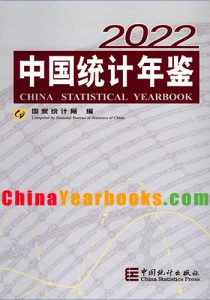China Statistical Yearbook 2022 Download
Yearbook title:中国统计年鉴2022
Yearbook English title:China Statistical Yearbook 2022
Published Date :09/2022
ISBN:978-7-5037-9950-1
Language : English and Chinese bilingual
Availability : Printed Version;Electronic Version(PDF Version)

Ⅰ.China Statistical Yearbook 2022 is an annual statistical publication,which reflects comprehensively the economic and social development of China.It covers data for 2021 and key statistical data in recent years and some historically important years at the national level and the local levels of province,autonomous region and municipality directly under the Central Government. Ⅱ.The Yearbook contains twenty-eight chapters:1.General Survey;2.Population;3.National Accounts;4.Employment and Wages;5.Prices;6.People’s Livelihoods;7.Government Finance;8.Resources and Environment;9.Energy;10.Investment in Fixed Assets;11.International Trade and Economic Cooperation;12.Agriculture:13.Industry;14.Construction;15.Wholesale and Retail Trades;16.Transport,Postal and Telecommunication Services,and Software Industry;17.Hotels,Catering Services and Tourism;18.Financial Intermediation;19.Real Estate;20.Science and Technology;21.Education;22.Public Health and Social Services;23.Culture and Sports;24.Public Management,Social Security and Social Organizations;25.Urban,Rural and Regional Development;26.Main Social and Economic Indicators of Hong Kong Special Administrative Region;27.Main Social and Economic Indicators of Macao Special Administrative Region;28.Main Social and Economic Indicators of Taiwan Province.One chapter listed as Appendix is Main Social and Economic Indicators of Other Countries/Regions. To facilitate readers,the Brief Introduction at the beginning of each chapter provides a summary of the main contents of the chapter,data sources,statistical coverage,statistical methods and historical changes.At the end of each chapter,Explanatory Notes on Main Statistical Indicators are included. Ⅲ.The national data in this book do not include those of the Hong Kong Special Administrative Region,the Macao Special Administrative Region and Taiwan Province,except for the divisions of administrative areas,forest resources and otherwise specified.In accordance with the principles set down in the Basic Law of Hong Kong Special Administrative Region,and the Basic Law of Macao Special Administrative Region,statistically Hong Kong,Macao and the mainland of China are three mutually independent regions,each following its own and different statistical systems and legal provisions in conducting statistical operation independently.Statistics on the Hong Kong Special Administrative Region and the Macao Special Administrative Region as included in this yearbook are provided by the Census and Statistics Department of the Government of Hong Kong Special Administrative Region and the Statistics and Census Service of the Government of Macao Special Administrative Region respectively;and are edited by the National Bureau of Statistics. Ⅳ.Eastern region,central region,western region and northeastern region in the Yearbook are divided as following: Eastern region with 10 provinces(municipalities) includes:Beijing,Tianjin,Hebei,Shanghai,Jiangsu,Zhejiang,Fujian,Shandong,Guangdong and Hainan; Central region with 6 provinces includes:Shanxi,Anhui,Jiangxi,Henan,Hubei and Hunan; Western region with 12 provinces(autonomous regions and municipalities) includes:Inner Mongolia,Guangxi,Chongqing,Sichuan,Guizhou,Yunnan,Tibet,Shaanxi,Gansu,Qinghai,Ningxia and Xinjiang; Northeastern region with 3 provinces includes:Liaoning,Jilin and Heilongjiang. Ⅴ.The units of measurement used in the Yearbook are international standard measurement units,and newly published and implemented Product Categories are uniformly used. Ⅵ.For updated historical data,please refer to the newly published version of the Yearbook.Statistical discrepancies on totals and relative figures due to rounding are not adjusted in the Yearbook. Ⅶ.Notations used in the Yearbook:(blank space) indicates that the data are unknown,or are not available;“#”indicates a major breakdown of the total;and “*”or“①”indicates footnotes at the end of the table.For notations in the chapters of data on Hong Kong SAR and Macao SAR,please refer to the brief introduction or explanation in the relevant chapters. Ⅷ.In comparison with China Statistical Yearbook 2021,following revisions have been made in this new version in terms of the statistical contents and in editing.In the chapter on “National Accounts”,input-output tables of intermediate use part,final use part and 17×17 product department are added.In the chapter on “People’s Livelihoods”,the per capita disposable income of rural households in the poverty relief counties of 22 provinces equivalent administrative units in central and western China are added.In the chapter on “Agriculture”,relevant indicators of “grain,soybean,sugar” have been added.In the chapter on “Transportation,Postal and Telecommunication Services and Software Industry”,the indicator “3G mobile phone subscribers” is revised to “5G mobile phone subscribers”.In the chapter on “Financial Intermediation”,increase the loan prime rate(LPR),relevant index data of Beijing Markets and bonds data in the interbank market.In the chapter on “Education”,the indicators of “consolidation rate of nine-year compulsory education”,”gross enrollment rate of high school education ” and “gross enrollment rate of higher education” are added,and the indicators of “regular higher education institutions”,”undergraduate in regular HEls “,”social donation funds”,”tuition and miscellaneous fees” are revised into ” regular and vocational higher education”,” regular and vocational colleges and universities”,”donation income” and “tuition” respectively.In the chapter on “Public Health and Social Services”,the indicators “number of inpatients “,”number of patients discharged” and “personal cash health expenditure” are modified to “inpatients”,”number of patients discharged” and “personal health expenditure” respectively.In the chapter on “Urban,Rural and Regional Development”,the data of the Yangtze River Delta has been added.